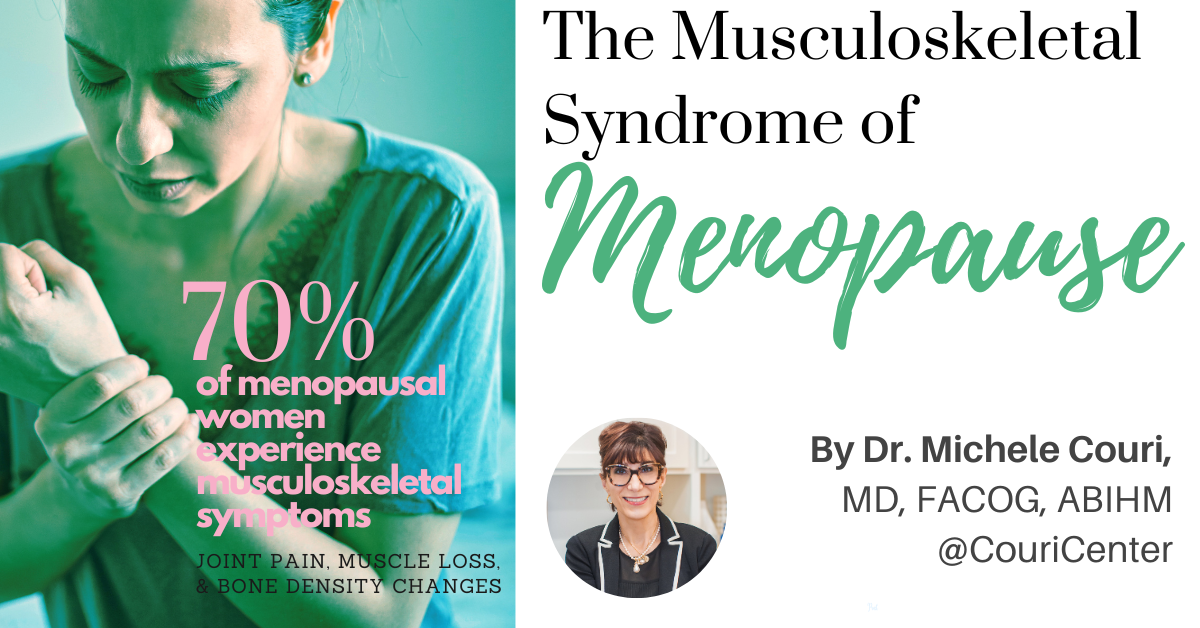
Summary
In her latest blog post, Dr. Michele Couri sheds light on the often-overlooked musculoskeletal syndrome of menopause, a condition that affects 70% of midlife women. Many women experience joint pain, muscle loss, and bone density changes during menopause, yet these symptoms frequently go unrecognized as part of the menopausal transition. Dr. Couri explains how the loss of estrogen contributes to these issues and highlights the importance of hormone therapy, which can reduce the risk of osteoporotic fractures by up to 37%, as well as proper nutrition and strength training in maintaining musculoskeletal health. If you’re experiencing these symptoms, Dr. Couri encourages you to take proactive steps and schedule a consultation to receive personalized care that can enhance your quality of life and well-being during menopause.
As we approach World Menopause Day on October 18th, 2024, the theme of hormone therapy serves as a vital focus for this year’s awareness efforts. This global event emphasizes the critical role hormone therapy can play in improving women’s quality of life during menopause. At the Couri Center, we are dedicated to educating and supporting women through personalized hormone therapy treatments and comprehensive care. Prioritize your health and well-being today—schedule a consultation to learn more about hormone therapy and how it can benefit you during menopause.
Discover how the loss of estrogen in menopause affects joint pain, muscle loss, and bone health.
In my practice, not a day goes by without hearing a perimenopausal or menopausal age woman tell me about the joint pain or body aches that she is experiencing. Patients frequently convey that these symptoms began around the time of their other more classic menopausal symptoms like hot flashes, night sweats, and changes in their menstrual cycle regularity. In fact, more than 35 symptoms are known to be associated with menopause, but very few women, and even very few healthcare providers, are aware of the musculoskeletal symptoms that can be attributed to menopause. I think that you will find the following statistics very enlightening and may answer questions that you may have regarding your own symptoms.
- The musculoskeletal syndrome of menopause is a relatively new term that describes the common musculoskeletal symptoms related to the loss of estrogen levels. Symptoms include: joint pain, inflammation, arthritis, loss of muscle mass, bone loss (osteoporosis) leading to increased risk of fractures, increased tendon and ligament injury, and cartilage damage.
- 70% of all midlife women will experience the symptoms of musculoskeletal syndrome of menopause, negatively affecting quality of life.
- The decrease in estrogen seen in perimenopause/menopause is linked to 5 significant changes in the body:
- An increase in inflammation
- Decrease in bone mineral density which can lead to osteopenia or osteoporosis
- Arthritis
- Loss of muscle mass
- Decrease in the proliferation of muscle stem cells
- Estrogen regulates levels of inflammation in the body, thereby reducing joint pain. Common inflammatory conditions seen in menopause include: joint pain, joint discomfort, and frozen shoulder.
- Estrogen has critical functions related to muscle mass and strength. In animal studies, 24 weeks of estrogen deficiency resulted in a 10% decrease in muscle strength and an 18% decrease in muscle fiber volume. Decreased muscle mass/strength can be associated with poor balance, increased risk of falls, loss of stamina, and decreased walking speed.
- Osteoporosis is a clinically significant disease that affects millions of women worldwide. Up to 50% of women will suffer a fracture sometime in their lifetime, and 70% of hip fractures occur in women. Osteoporosis is more common in menopausal women, mostly attributable to the decline in estrogen as we age. Treatment of menopausal women with hormone therapy is able to preserve or increase bone density and can decrease the risk of osteoporotic fractures. Menopausal hormone therapy reduces the incidence of osteoporosis by up to 37%.
- Decreased estrogen levels seen in menopause are associated with loss of type II muscle fibers and reduced muscle strength. Women lose 0.6% of muscle mass per year after menopause. With loss of estrogen at menopause, it often becomes more difficult to build muscle. Resistance training along with proper nutrition, adequate intake of protein, and targeted supplementation is critical to increase muscular power.
- Menopausal hormone therapy with estrogen may mitigate the bothersome and potentially dangerous aspects of the musculoskeletal syndrome of menopause.
- Working with healthcare providers who understand and recognize the devastating effects of the musculoskeletal syndrome of menopause is crucial to optimizing both quality of life and vitality at this important stage of our lives.
If you believe that you are suffering from any or all aspects of the musculoskeletal syndrome of menopause, schedule your visit online or call 309-692-6838– new patients are welcome. We’re here to help!
To Your Health,
Dr. Couri
Sources Used:
Wright, Vonda, et al. The musculoskeletal syndrome of menopause. Climacteric. 2024, Vol. 27, No. 5, 466-472.
Kitajima, Y, et al. Estrogens maintain skeletal muscle and satellite cell functions. J Endocrinol. 2016;229(3):267-275.
Genazzani, AR, et al. Postmenopausal osteoporosis: therapeutic options. Climacteric. 2005;8(2);99-109.
DISCLAIMER: The information provided on this website is intended for general informational purposes only and is not intended to be a substitute for professional medical advice, diagnosis, or treatment. The information provided is current as of the date of publication or last review, but medical knowledge is constantly evolving, and the information may become outdated over time
